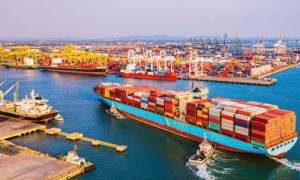The US-China rivalry in east Asia has taken an interesting turn after the recent visit of US defense secretary, Lloyd Austin, to the Philippines. Austin’s trip ended in an expanded deal, the enhanced defense cooperation agreement (EDCA).
This gives the US access to four additional military bases in a highly strategic region, a significant move for the Philippines, which – not so long ago – had signalled its intention to prioritise its friendship with China over the US.
Since Ferdinand “BongBong” Marcos took office as president in June 2022, the US has revitalised its engagement with the Philippines. In July, Washington appointed career diplomat MaryKay Loss Carlson as its ambassador, filling a post that had been vacant since 2020.
Washington and Manila had enjoyed a strong relationship since the end of the second world war, characterised by a continual US military presence. This was crucial during the Vietnam war and afterwards enabled a significant and continuing US military presence in the region.
But the relationship soured after the election of Rodrigo Duterte as president in 2016, who made it clear he wanted to prioritise a relationship with Beijing over Washington.
A low point was reached in 2020 when Duterte announced his decision to terminate the visiting forces agreement controlling bilateral military arrangements including legal jurisdiction over US troops in Philippines and vice versa. The Philippines president subsequently reversed his decision in 2021, admitting he had done so in return for access to COVID-19 vaccines during the pandemic.
But Duterte’s antagonism towards the US and his growing closeness to Beijing had threatened to tilt the scale of geopolitics in the region at a time of mounting tensions across east Asia over Chinese expansion.
Meanwhile in the US, anger at Duterte’s shocking human rights abuses, including the extra-judicial killings of thousands during his “war in drugs” in 2016 and 2017 prompted the US Congress to debate a bill in September 2020 suspending all security aid to the Philippines.
Duterte, meanwhile, had been telling Beijing it was “time to say goodbye to Washington” and pursue closer relations with China. But this flirtation with China ultimately came to nothing. The South China dispute was left to rumble on in the background and Duterte did his best to ignore the issue.
Reviving an old friendship
During the 2022 presidential election campaign Marcos remained vague about the direction of his foreign policy. He hedged between his problematic family history with the US – which had played an important role in ending his father’s dictatorship – and the ongoing South China Sea dispute that has pitted Beijing against most of the rest of the region over China’s territorial claims.
But since assuming office, Marcos has been firm in keeping the alliance with the US strong, and America’s attitude towards the Philippines has thawed. For Washington’s part, the Philippines’ strategic importance to the US has only increased as China continues enact its claims to islands in the South China Sea with a growing military presence.
Washington is also disturbed by Beijing’s repeated statements about its desire to “reunify” with Taiwan and the increasingly authoritarian nature of its administration of Hong Kong.
Austin’s trip marks the third high-profile visit by a US official during the first year of the Marcos presidency. In November 2022, US vice president Kamala Harris visited Palawan, a strategically important archipelago abutting the South China Sea, meeting with coast guard officials there.
It was a historic visit of a high-ranking US official to the home of the Philippine’s western command whose main area of responsibility is the West Philippine Sea, the sovereignty of which is hotly contested by China. Harris reaffirmed US support for the defence alliance and keeping the Indo-Pacific free and open.
US secretary of state, Antony Blinken, also visited the Philippines in August 2022 at the same time as the former house speaker, Nancy Pelosi, made her controversial visit to Taiwan. Blinken reassured Marcos of Washington’s “iron-clad commitment” to the countries’ mutual defense treaty. Now Austin’s visit has gained the Philippines an expanded defence agreement and a potential US$100 million (£84 million) in military aid.
Local and global politics collide
The enhanced defense cooperation agreement was negotiated and signed in 2014 by the countries’ respective presidents at the time, Barack Obama and Benigno Aquino. The new detente between the Biden and Marcos administrations has returned the relationship between the two countries to a firmer footing and suggests that “America’s pivot to Asia” has survived the pressures of the Trump administration’s isolationism, Duterte’s belligerence and China’s increasing assertiveness in the region.
The agreement over the additional bases under the EDCA was initially negotiated in September 2022 by Austin and the newly appointed national defence senior undersecretary Jose Faustino at a meeting in Hawaii, so Beijing was well aware that the announcement was in the offing.
The maintenance of US influence in the east Asia region remains a plank of Washington’s security strategy, something it ensures by making nations like the Philippines chose sides periodically. Thailand, a staunch US ally during the Vietnam War which felt abandoned after the 1975 withdrawal, has been pulled in both directions too.
China has criticised the latest strengthening of the EDCA as an agreement that would “escalate regional tension and undermine regional peace and stability”.
Meanwhile Marcos – who said in January that the South China Sea issue was “keeping him awake at night” – is taking great pains to remain at least on terms with Beijing. Earlier this year, Marcos secured US$22.8 billion in new investment deals in January during a meeting with Chinese president Xi Jinping in Beijing.
Since Russia’s invasion of Ukraine a year ago, Washington has committed significant amounts of money and military support to Ukraine. But America’s greatest adversary still looms in the Indo-Pacific. And nations caught in between the two biggest global powers will continue to be bargaining chips for the two major powers while trying to get the best deal they can for themselves.
Source: The Conversation





















